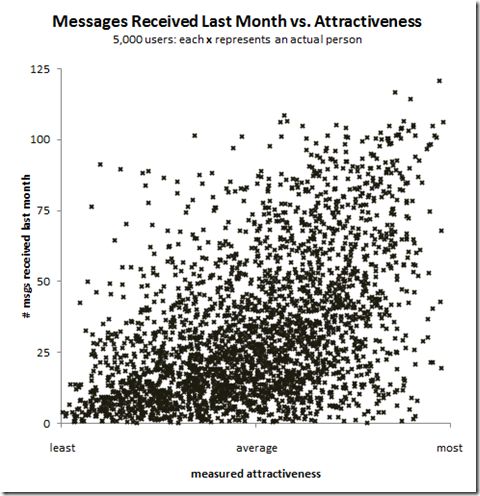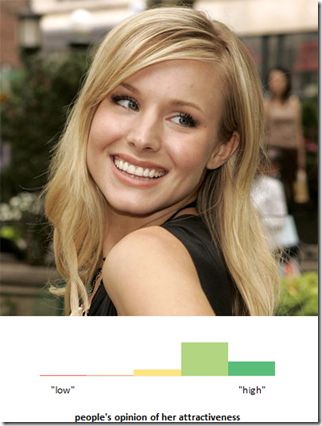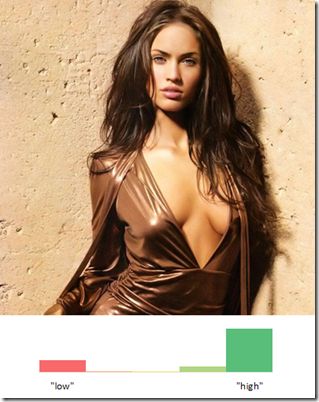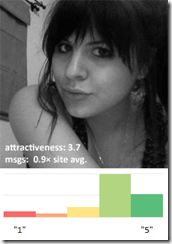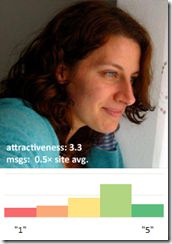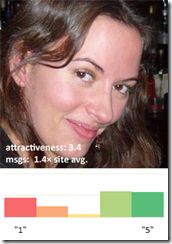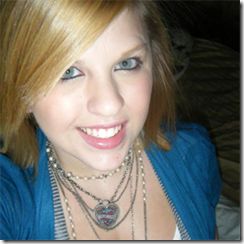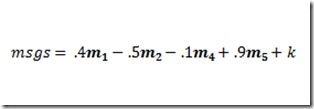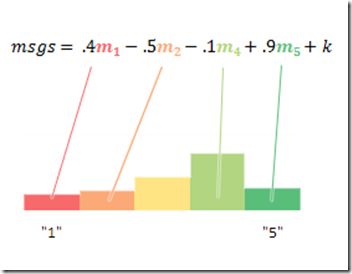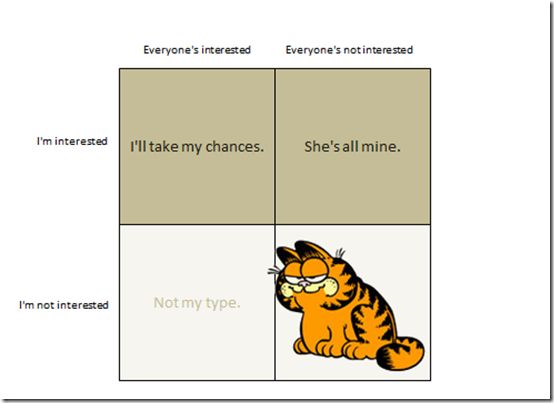The Mathematics Of Beauty
[婚恋交友中,女性想要收到更多异性的信件,得多贴些有争议的照片,而不是贴那些大家都觉得不错的照片。这个结论来自于OkCupid的数据科学家,原文见这里。OkCupid号称online dating行业的Google,向他们学习。]
[本文链接:http://www.cnblogs.com/breezedeus/archive/2012/10/28/2744002.html,转载请注明出处。]
The Mathematics Of Beauty
January 10th, 2011 by Christian Rudder
This post investigates female attractiveness, but without the usual photo analysis stuff. Instead, we look past a woman's picture, into the reaction she creates in the reptile mind of the human male.
Among the remarkable things we'll show:
Fair warning: we're about to objectify women, big-time. The whole purpose of this blog is to analyze OkCupid's data, and without a little bit of objectification that's impossible. Men will get their turn under the microscope soon enough. As usual, none of this (with the exception of the celebrity examples) is my opinion. All data is collected from actual user activity.
Let's start at the beginning.
All people, but especially guys, spend a disproportionate amount of energy searching for, browsing, and messaging our hottest users. As I've noted before, a hot woman receives roughly 4× the messages an average-looking woman gets, and 25× as many as an ugly one. Getting swamped with messages drives users, especially women, away. So we have to analyze and redirect this tendency, lest OkCupid become sausageparty.com.
Every so often we run diagnostic plots like the one below, showing how many messages a sampling of 5,000 women, sorted by attractiveness, received over the last month.
These graphs are adjusted for race, location, age, profile completeness, login activity, and so on—the only meaningful difference between the people plotted is their looks. After running a bunch of these, we began to ask ourselves: what else accounts for the wide spread of the x's, particularly on the "above-average" half of the graph? Is it just randomness?
What is it about her:
that gets more attention than her:
...even though according to our users, they're both good-looking?
Not all 7s are the same
It turns out that the first step to understanding this phenomenon is to go deeper into the mathematically different ways you can be attractive.
For example, using the classic 10-point 'looks' scale, let's say a person's a 7. It could be that everyone who sees her thinks exactly that: she's pretty cute.
But something extreme like this could just as easily be going on:
If all we know is that she is a 7, there's no way to tell. Maybe for some guys our hypothetical woman is the cat's pajamas and for the rest she's the cat Garfield. Who knows?
As it turns out, this distribution of opinions is very important.
Celebrity photos: to titillate and inform
Let's look at what the ratings distribution might be for a couple famous people. I imagine that for, say, the actress Kristen Bell it would be roughly like this:
Ms. Bell is universally considered good-looking, but it's not like she's a supermodel or anything. She would probably get a few votes in the 'super hot' range, lots around 'very attractive', and almost none at the 'unattractive' end of the graph.
Compare her to Megan Fox, who might rate like this:
On the far right, you have the many dudes who think she's the sexiest thing ever. On the far left, you have the small number of people who have seen her movies.
Unlike Ms. Bell, Ms. Fox produces a strong reaction, even if it's sometimes negative.
Real People
Now let's look back at the two real users from before, this time with their own graphs. OkCupid uses a 1 to 5 star system for rating people, so the rest of our discussion will be in those terms. All the users pictured were generous and confident enough to allow us to dissect their experience on our site, and we appreciate it. Okay, so we have:
As you can see, though the average attractiveness for the two women above is very close, their vote patterns differ. On the left you have consensus, and on the right you have split opinion.
To put a fine point on it:
- » Ms. Left is, in an absolute sense, considered slightly more attractive
- » Ms. Right was also given the lowest rating 142% more often
- » yet Ms. Right gets 3× as many messages
When we began pairing other people of similar looks and profiles, but different message outcomes, this pattern presented itself again and again. The less-messaged woman was usually considered consistently attractive, while the more-messaged woman often created variation in male opinion. Here are a couple more examples:
We felt like were on to something, so, being math nerds, we put on sweatpants. Then we did some work.
Our first result was to compare the standard deviation of a woman's votes to the messages she gets. The more men disagree about a woman's looks, the more they like her.We found that the more men disagree about a woman's looks, the more they like her. I've plotted the deviation vs. messages curve below, again including some examples.
The women along the graph are near the 80th percentile in overall attractiveness. You can click the tiny thumbnails to expand them.
As you can see, a woman gets a better response from men as men become less consistent in their opinions of her.
Our next step was to analyze a woman's actual vote pattern of 1s, 2s, 3s, 4s, and 5s:
If You're Into Algebra
We did a regression on the votes for and messages to a sample of 43,000 women. To keep everything consistent, all the women were straight, between the ages of 20 and 27, and lived in the same city. The formula given in the body of the post was the best-fit we found on our second regression, after dropping the m3 term because its p-value was very near 1.
msgs are the number of messages the woman received during the observation period. The constant k reflects her overall level of site activity. For this equation, R2 = .28, which isn't great in a lab or on a problem set, but is actually very good in a real-world environment.
This required a bit more math and is harder to explain with a simple line-chart. Basically, we derived a formula to predict the amount of attention a woman gets, based on the curve of her votes. With this we can translate what guys think of a woman's looks into how much attention she actually gets.
The equation we arrived at might look opaque, but when we get into it, we'll see it says some funny things about guys and how they decide which women to hit on.
The most important thing to understand is that the ms are the men voting on her looks, making up her graph, like so:
And those ms with positive numbers in front contribute to messaging; the ones with negative numbers subtract from it. Here's what this formula is telling us:
The more men who say you're hot, the more messages you get.
How we know this—the .9 in front of m5 is the biggest positive number, meaning that the guys who think you're amazing (voting you a perfect '5') are the strongest contributors to your messaging income. This is certainly an expected result and gives us some indication our formula is making sense.
Men who think you're cute actually subtract from your message count.
How we know this—because the .1 coefficient in front of m4 is negative. This tells us that guys giving you a '4', who are actually rating you above average-looking, are taking away from the messages you get. Very surprising. In fact, when you combine this with the positive number in front of the m1 term, our formula says that, statistically speaking:
If someone doesn't think you're hot, the next best thing for them to think is that you're ugly.
This is a pretty crazy result, but every time we ran the numbers—changing the constraints, trying different data samples, and so on—it came back to stare us in the face.
What We Think Is Going On
So this is our paradox: when some men think you're ugly, other men are more likely to message you. And when some men think you're cute, other men become less interested. Why would this happen? Perhaps a little game theory can explain:
Suppose you're a man who's really into someone. If you suspect other men are uninterested, it means less competition. You therefore have an added incentive to send a message. You might start thinking: maybe she's lonely. . . maybe she's just waiting to find a guy who appreciates her. . . at least I won't get lost in the crowd. . . maybe these small thoughts, plus the fact that you really think she's hot, prod you to action. You send her the perfectly crafted opening message.
"sup"
On the other hand, a woman with a preponderance of '4' votes, someone conventionally cute, but not totally hot, might appear to be more in-demand than she actually is. To the typical man considering her, she's obviously attractive enough to create the impression that other guys are into her, too. But maybe she's not hot enough for him to throw caution (and grammar) to the wind and send her a message. It's the curse of being cute.
The overall picture looks something like this:
Finally: What This Could Mean To You
I don't assume every woman cares if guys notice her or not, but if you do, what does all the above analysis mean in practical terms?
Well, fundamentally, it's hard to change your overall attractiveness (the big single number we were talking about at the beginning). However, the variance you create is under your control, and it's simple to maximize:
Take whatever you think some guys don't like—and play it up.
As you've probably already noticed, women with tattoos and piercings seem to have an intuitive grasp of this principle. They show off what makes them different, and who cares if some people don't like it. And they get lots of attention from men.
But our advice can apply to anyone. Browsing OkCupid, I see so many photos that are clearly designed to minimize some supposedly unattractive trait—the close-cropped picture of a person who's probably overweight is the classic example. We now have mathematical evidence that minimizing your "flaws" is the opposite of what you should do. If you're a little chubby, play it up. If you have a big nose, play it up. If you have a weird snaggletooth, play it up: statistically, the guys who don't like it can only help you, and the ones who do like it will be all the more excited.
Journalists, please write [email protected] for more information.


